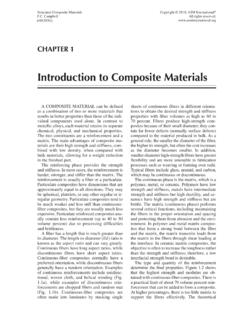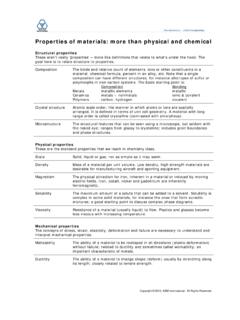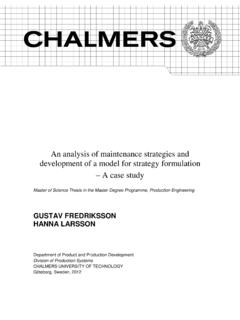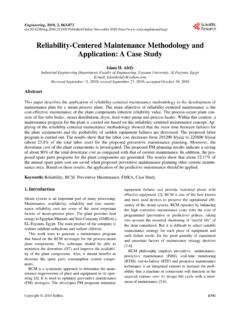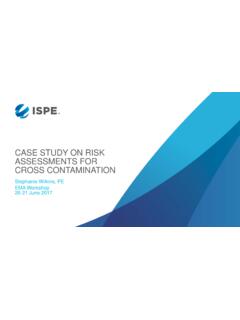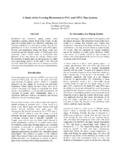Transcription of Fatigue of Threaded Fasteners - ASM International
1 Alex Hudgins*Brad James,*FASM Exponent FailureAnalysis AssociatesMenlo Park, Calif. ADVANCED MATERIALS & PROCESSES AUGUST 201418 Fasteners play a critical role in engineeredstructures as a method of nonpermanentjoining for the aerospace, infrastructure,civil, automotive, energy generation/distribu-tion, and many other industries. Fastener fail-ures can lead to disastrous consequences andsubstantial financial losses. One of the mostcommon fastener failure modes is Fatigue crackinitiation and growth. Inadequate design con-siderations, material problems, insufficient pre-load, loosening, and excessive loads can allcontribute to fastener Fatigue .
2 Fastener failure backgroundSimilar to other metallic components, fas-tener failures include overload, corrosion-related cracking, embrittlement, creep, and fa-tigue. Fastener overload can occur upon in-stallation or in service due to an externallyapplied load. Fastener overload failure investi-gation should include assessment of the mate-rial properties to determine fastener strength,as well as the loads that contributed to thebreak. Stress corrosion cracking (SCC), or hy-drogen embrittlement in some metals, repre-sents an important failure mode in fastenersdue to the static tensile nature of the loadingin many applications.
3 Given the expectedstresses on Fasteners , the material and envi-ronment must be carefully considered to appropriately mitigate SCC or hydrogen em-brittlement embrittlement can also becaused by improper manufacturing conditions,particularly in plating processes. To reduce hy-drogen embrittlement in susceptible materials, Fasteners must be subjected to appropriate bak-ing treatments. Creep failures can occur whenfasteners are subjected to sufficient stress at el-evated temperatures. Again, stresses, materials,and the environment (temperature) must beconsidered to help mitigate creep damage andpotential failure .
4 Fastener fatigueFatigue is the most common form of frac-ture of metal structures, accounting for up to80% of all costs associated with fracture. Fas-teners are no exception, as Fatigue remains themost common cause of fastener breaks. Fatiguecrack initiation and growth occurs when cyclicstresses exceed the Fatigue strength of local ma-terial for a sufficient number of loading material, geometry, stress amplitude,mean stress, and assembly parameters all affectfatigue performance[3]. The fastener assembly process is one of themost important, but often overlooked, contrib-utors to Fatigue performance.
5 The cyclic-stressamplitude imposed on a given fastener (andtherefore Fatigue performance) is highly dependent on preload. Specifically, increasedpreload results in decreased cyclic stress-am-plitude, particularly at loads below the clamp-ing force imposed by the fastener. To illustrate,Fig. 1 includes a series of schematics from theASM Metals Handbookshowing the differencesbetween an ideal joint (Fig. 1b) and an actualFatigueof Threaded FastenersFasteners playa critical rolein many engineeringstructures, andtheir failurecan result insignificantconsequences. *Member of ASM InternationalFig.
6 1 Schematics from the ASM Metals Handbook highlight the difference betweenideal behavior shown in (b) and real behaviorshown in (c)[3]. aug amp features_am&p master template new 7/23/2014 9:44 AM Page 18joint (Fig. 1c)[3]. As indicated, loading on the bolt is mini-mal until the working load exceeds preload. Thus, for acondition where cyclic loads are smaller than preload, lit-tle or no cyclic damage occurs to the fastener. The conceptof higher preloads resulting in increased Fatigue perform-ance may be counterintuitive, which might otherwise sug-gest that increasing the tightening force of a bolt mayincrease propensity for failure .
7 Insufficient preload hasbeen attributed to the cause of the majority of fastener fa-tigue failures[4]. Therefore, understanding preload is criti-cal in both the design and failure analysis of Fasteners . Pretension is often adjusted by applying torque to thebolt, screw, or nut. Torque application increases tension inthe fastener and clamping force between components. It isnecessary to understand the difference between clampingforce and the amount of torque applied to the screw orbolt. These two metrics generally correlate, but are differ-entiated by frictional forces. Fatigue susceptibility can bereduced by increasing clamping force and fastener tension,which is most often controlled by applied torque.
8 However,factors such as material hardness and surface finish affectfriction[3], and therefore affect the extent to which appliedtorque is translated into increased fastener tension andclamping force. Guidance is provided with respect to the degree towhich Fasteners should be tightened. Bolts in tensionshould exert as much force on the joint as it and the jointmembers will stand[4]. A rule of thumb is to load the bolt to60% of the material s yield strength[5]. While tension and high clamping force are critical forjoints, applied forces (often cyclic) can significantly reducepreload.
9 Generally, increased preload reduces the propen-sity for fastener loosening. To minimize susceptibility toloosening, the highest preloads possible should be used up to, but not exceeding yield[4]. Loosening reduces pre-load and the force required for joint separation, and cangreatly increase the propensity for Fatigue failure and fret-ting. However, increasing the preload also increases sus-ceptibility to overload upon installation, or may increasesusceptibility to SCC. Excessive preloads can also increase mean stress to lev-els that may contribute to Fatigue for joints subjected to rel-atively low cyclic stress amplitudes.
10 The effect of increasedmean stress on Fatigue performance is often described by aGoodman line, which plots stress amplitude as a functionof mean stress. A schematic Goodman line is shown inFig. 2, where increasing mean stress results in decreasedability for the component to withstand applied alternatingstress. As shown by the Goodman line, excessive meanstresses (near the fastener tensile stress) can reduce fatigueperformance. However, in most joints, high preloads pre-clude significant cyclic stresses, as shown in Fig. 1. Hex-head case studyA short case study highlights some common issues ob-served in fastener failures.








